- Urvi Shah
- Sep 30, 2023
- 23 min read
Updated: Nov 16, 2023
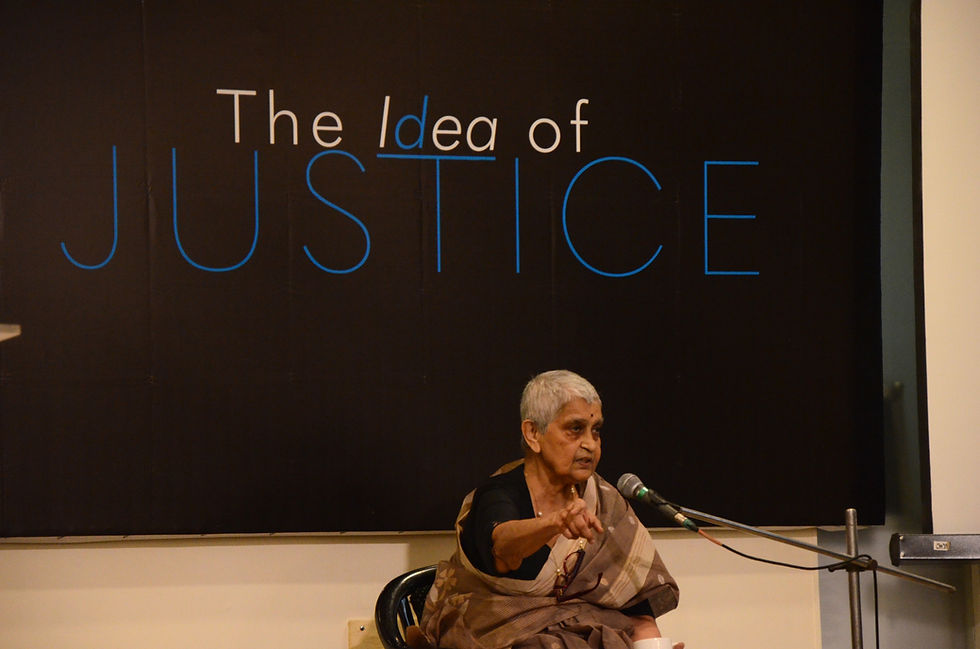
The annual History for Peace conference—The Idea of Justice—was held at the Tollygunge Club, Calcutta between August 3 and 5, 2023. The conference brought together public intellectuals—academics, lawyers, activists, educationists and artists—from across south Asia and the diaspora with diverse areas of professional expertise and a wealth of life experience to reflect on their perception of different dimensions of the idea of justice. Conversations ranged from the densely theoretical to deeply personal. While some debated Bertolt Brecht’s controversial position on empathy as extractive voyeurism and questioned whether empathy is the ideal means of instilling a sense of justice in the classroom, others discussed how a personal emergency surrounding a beloved pet awakened them to the everyday realities of injustice encountered by the community with whom they worked. At the workshops, conversations ranged from the representation of injustice in Barbie and Oppenheimer and the understanding of health and able-bodiedness as a privilege. Through these formal and informal exchange of ideas and recurring themes which transcended niche boundaries, emerged the distinction between law and justice, justice and ethics; the necessity of grappling with historical injustices and the urgent need to foster a sense of justice in school-level pedagogy and scholarship.
DAY 1 | August 3, 2023
The Idea of Justice opened with Naveen Kishore’s inaugural address that outlined the broad scope of the philosophy of justice and set the scene for the three days that followed. He began by concentrating upon the idea of justice on the self and bringing it to the microcosm, therefore asking: What happens to the sense of self when met with injustice. In this larger reading of justice historically, his emphasis lay on realizing the individual or the common citizen as one who is more often than not thrust into the folds of history without having actively made the choice to do so. What, then, does it mean to bear witness? Seeing cynicism as virtue, for it is that which challenges the status quo, he asks: What will happen as our stories are now being erased with specific emphasis on the rewriting of textbooks as acts of erasure coupled with a further dwindling interest in studying history today. This led up to his final questions in that direction: What is just? What makes it so? And understanding its relation to the opposite, that is the lack of justice or the unjust. He concluded with a reminder that the idea of justice is under threat today, therefore locating the conference in the specificities of its time and space, while also situating it historically.
Gayatri Chakravorty Spivak delivered the keynote address: It is Just that there be Law, but Law is not Justice. The title of the talk itself draws from Jacques Derrida’s philosophical interventions which was the major focus of Spivak’s early scholarship. However, Spivak takes Derrida’s intervention further and beyond in significant ways. The lecture began with Spivak unpacking the title of her talk, emphasizing the distinction between the ‘idea of justice’ and the ‘sense of justice’, explaining her preference for the latter because it is embedded within cultural practice. She locates this within a larger reading of the humanities, a field she finds distinctive because it teaches the ‘practice of learning’. She calls upon the audience to never lose sight of who dispenses justice; the who will go on to determine justice for whom, its specific meaning in the context of its dispensation, and presence or the lack of justice in what ways. Another central argument that runs through her lecture is the idea of justice being transcendental. She strictly differentiates the transcendental nature of justice from the supernatural—for which it is usually misunderstood. The latter assumes that there is justice but justice cannot be accounted for. Spivak goes on to claim that passing good laws is not justice, rather good laws have to be enforced, and there are loopholes in the process of transitioning them into practice.
Spivak concluded by urging teachers in the audience to not reduce their time and space of teaching into survey reports, therefore cautioning them against the practice of teaching becoming reductive in nature. Instead, she encouraged them to undertake an activist-like reading of history whereby they take knowledge from one source and utilize it elsewhere, producing a new reading of history. Finally, she concludes by observing that justice and revenge often become indistinguishable—quest for justice for one, might seem like revenge to the other.
The keynote was followed by Krishna Kumar's talk titled, Learning Status—and the Rarity of Justice, in which he contextualized the idea of justice to the classroom and focussed on the barriers to justice. He began with an anecdote from a child, who when asked ‘If you meet God, what would you ask him?’ replied ‘I would ask, why would you make me so poor?’ This incident revealed a profound understanding of injustice a child may have and the realization that the search for justice is a long process that may never come to fruition. He notes that as per the state, the child is dependent, i.e someone must assert rights on behalf of the child. The state uses education to hone the child into an ideal citizen who can assert rights. However, education too manifests as a system, a divided system with a sharp distinction between public and private schools. In government schools, the child is an advertisement of the state, where the child is supposed to be grateful to the state. This indebtedness to the state exceeds the learning aspect of education in these spaces.
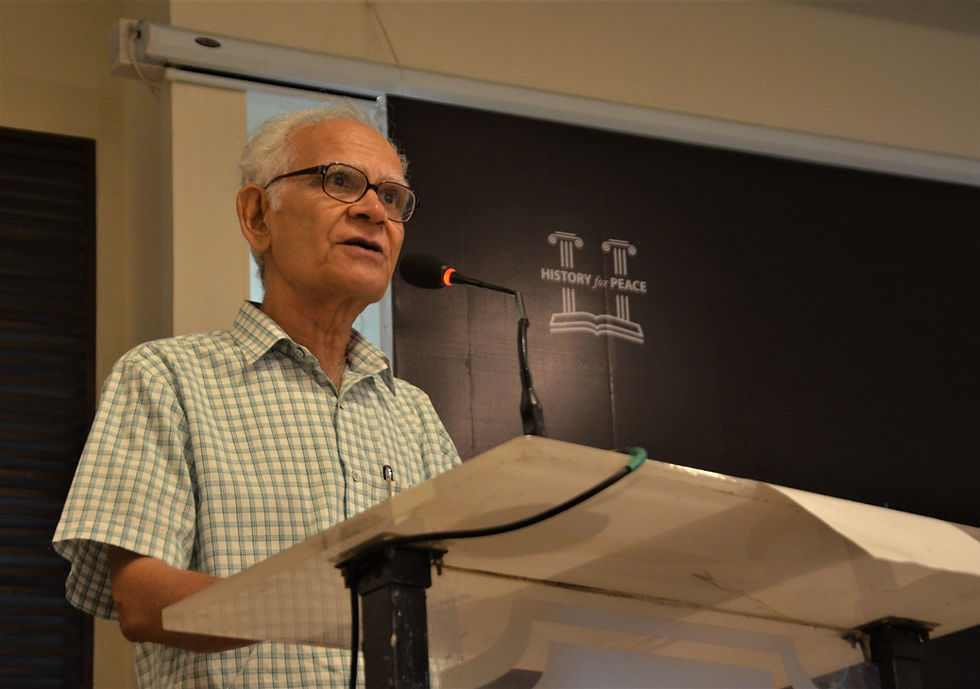
Further, he comments that this divided system is supposedly bridged by the offer of smartphones to government school children, to give them access to the internet and introduce them to mass culture. Mass culture manages to convey a fiction of equality and hide these injustices which even a child may perceive. Kumar proceeded to read out an anecdote from Rohith Vemula’s speech that beseeched that people be treated as minds rather than votes. Vemula’s death was one shocking incident that penetrated the ignorant veil of mass culture. The idea of justice is difficult to disassociate from democracy. Kumar recalled Ambedkar’s understanding of ‘association’ through endosmosis, which he found lacking in Indian society. Democracy promises that justice can be achieved. This can perhaps be achieved by practising Ambedkarite ‘association’.
Next, Meenakshi Gopinath's lecture on Her Peace: WPS—“Agenda” to “Engagement” encompassed a broad reading of women’s role in conflicts, wars, security and in their resolutions, as well as how women are framed within disciplines like international relations (IR). Gopinath began with an emphasis on the urgency of gendering the security framework through which IR is studied in the first place. She claimed that for the longest time, IR has been envisioned as an exclusively masculine space. There is, therefore, a pressing need to develop an alternate vocabulary to this masculinist discourse.
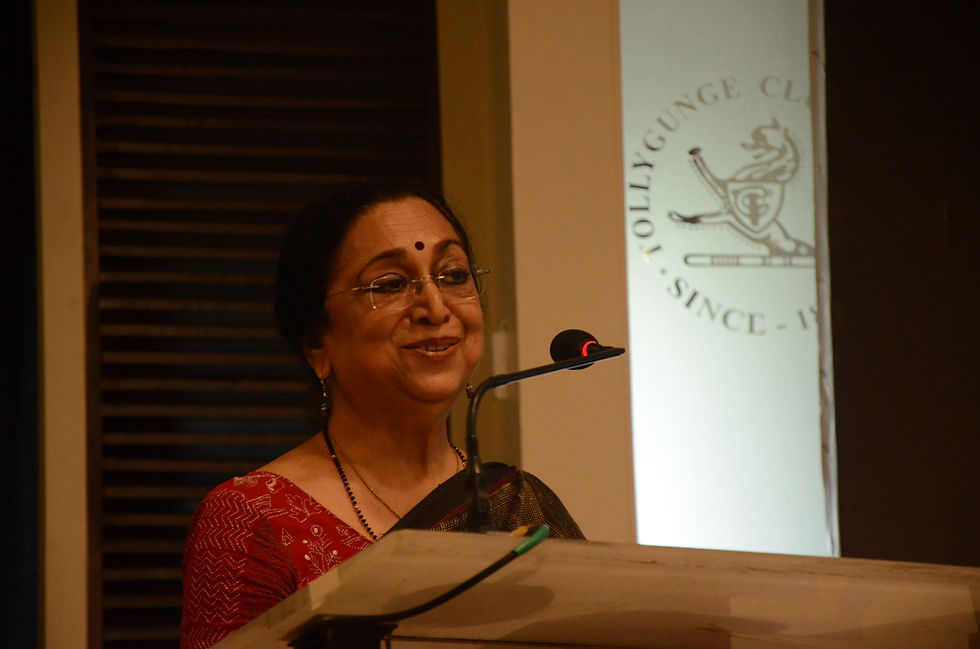
With the adoption of United Nations Security Council Resolution 1325, a landmark policy intervention calling for equal space for women and ensuring their active involvement in questions of humanitarian crises, security enforcement and peacebuilding, she invited the audience to realize the scope of this intervention. Her emphasis lay on cautioning them against the usual oversimplification and stereotypical assumptions that reduce women as passive subjects, equating them to being symbolic to peace, therefore ensuring no place for reductive binaries such as these. She called for reevaluating the idea of peace itself in the first place as an active humanitarian intervention and locating women as gendered subjects therein. Here she cites several examples across history, starting from Rosa Parks. She argues that peacebuilding be imagined towards bringing epistemic justice. Feminist readings within the International Relations Scholarship have made substantial interventions in addressing local to global challenges in questions of conflict, peace and security. She emphasizes on the impossibility to disengage protest from peace, citing examples across the various social movements from Chipko, Chamoli to Shaheen Bagh more recently.
In understanding the specific scope of gendering war, peace and security within the context of the subcontinent, she argues that honour of the community is scripted on women’s bodies given the nature of markers such as religion and caste, tracing the conversation back to the Abducted Persons (Recovery and Restoration) Act following Partition which made no place for women’s agency, instead the state forcefully bringing them back to families of their ‘original’ religion neglecting all realities of their married life in that moment. This, as she pointed out, was similar to the Veeranganas of 1970 Bangladesh. She argued that women engaged with peacebuilding at two levels, Bricolage and Transgression, where both complement each other. She emphasized that rape has been recognized as a war crime only as late as 2002, thus reminding the audience the very long drawn and extensive process that goes into bringing such policy interventions. She concluded with discussing women’s role in conflict prevention, like the All Women’s Peacekeeping forces in Liberia.
Prof. Apoorvanand, tackled the important question of injustice in the last talk of the day, titled, The Question of Cultural Injustice and Political Injustice, through the understanding of culture as a confluence of time and space. He argued that time is infused with a sense of possibility through movement, much like democracies are infused with the possibility of justice. However, he asked the audience if we have moved forward since last year, poignantly stating that he was enveloped with ‘the feeling of time collapsing’. Not everyone has the privilege of the experience of linear time. Raising the examples of Zakia Jafri and Bilkis Bano, still battling in their quest for justice promised to them by democracy, he argued that they have been forsaken by time as well. The courts, by denying them justice, won’t let them move on in time. The denial of promised justice, the divide in experience of time leads to cultural injustice.
He recalled Adorno’s maxim that the premier demand on all education was that Auschwitz not happen again. Adorno’s call was not limited to Europe. After the experience of 2002, we should have sworn that it would never happen again. This cultural injustice being faced by many groups in the country is the result of the demand for a unificatory nation. However, there is something very perverse about this notion of solidarity; it is contingent on the creation of outsiders and non-members. The understanding of nation itself rests on dispossessing those that do not fit within the dictated model of nationhood. Therefore, those demanding common solidarities in the plural and shared membership are facing grave crises. Culture serves as a reference point for making meaning of ourselves so the experience of cultural injustice is an attack on the self.
DAY 2 | August 4, 2023
The second day opened with Suraj Gogoi's discussion on the notions of citizenship, tolerance and ‘othering’ through the lens of the Constitutional Amendment Act (CAA) and the National Register of Citizens (NRC), and the everyday ramifications of the latter upon his home state of Assam. His talk titled, Right to Hospitality and Citizenship problematized the predicates of tolerance, and sought to replace it with the broader idea of hospitality. He argued that tolerance, which emerged as a political goal during the British-enforced partition of the Indian subcontinent in 1947, strengthens the ‘tyranny of the majority’, permits subscription to the philosophy of ‘live and let live’ and does not amount to subversive or substantive justice. Using the Zapatista slogan, ‘learning the otherness of others’, Gogoi reflected on hospitality beyond tolerance, while also recognizing the subjective political choice innate in hospitality—‘who do we trust with our warmth and respect?’
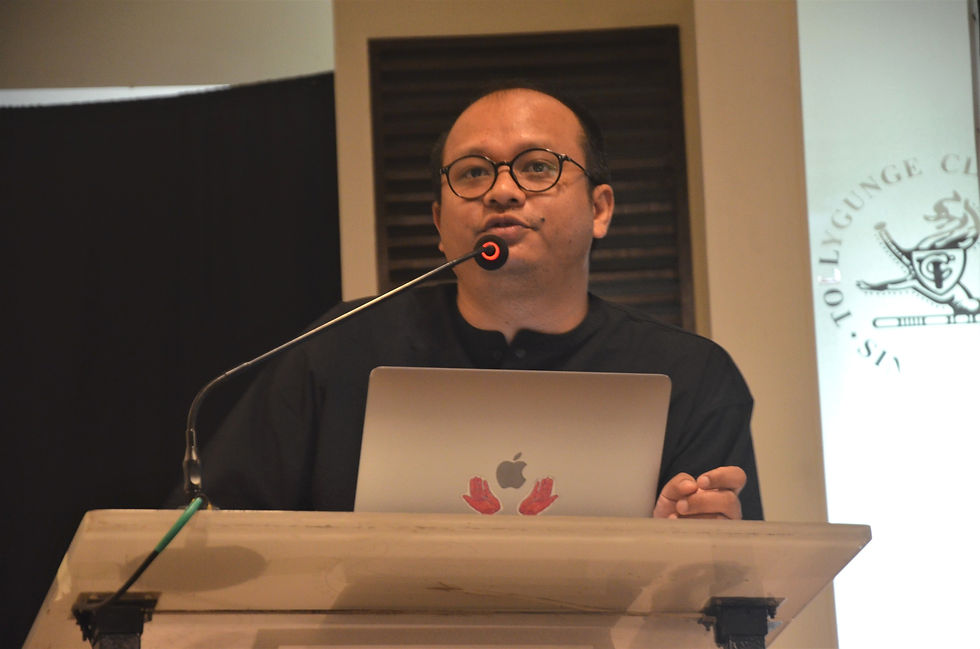
Drawing from the case of Safiqul Islam, arrested on the alleged charge of drunkenness and brutally murdered by the police at Batardrava police station in Assam after his family failed to pay the financial bribe the police demanded for his release, Gogoi illustrated the state’s hostility towards Muslims. The police retaliated by arresting Safiqul’s minor daughter under the draconian Unlawful Activities (Prevention) Act and Safiqul’s brother was found dead in an ‘accident’ after Safiqul’s community protested his illegal custodial murder. Gogoi argued that the denial of a home and history constitutes the ‘pinnacle of hostility’, as opposed to the hospitality to which Safiqul should have been entitled.
Gogoi endorsed Primo Levi’s understanding of hospitality—that you can share bread (or be hospitable) with your neighbour even when you are in a death camp facing extermination. Yet, reflecting on Ambedkar’s view that India can never be a true fraternity because of the immobility of caste, Gogoi pondered the reality of hospitality in India. Referring to the language used by Gandhi with regards to refugees during the Partition—that the helpless must ask for help and rights must be earned—Gogoi posited that Gandhi’s view on refugeehood seemed to precondition acceptance of the refugee on their registration as political beings. This, to Gogoi, is a violent idea.
Thus, underscoring the limitations of hospitality in Indian history, Gogoi claimed that othering and inhospitality also follows a chronology. For instance, the Indian government’s inhospitality to Bengali Muslims from Assam corresponds with Assamese history of ‘othering’ the ‘Bongal’ (the slur used in Ahomiyan literature to refer to immigrants who came from the west of Assam). The Indian home minister referring to Bengali Muslims as termites corresponds with the New York Times’ infamous reference to Jews as termites in the early twentieth century. British colonial officer, C. S. Mullan describing rising rates of Muslim immigration into Assam as an invasion by ‘a large body of ants’ in the 1931 census is illustrated by contemporary Assamese political graffiti depicting Muslims as swarms of ants, that Gogoi encountered during his fieldwork.
Shrimoyee Ghosh followed with her lecture titled, Notes on Law and Lawlessness in Kashmir. A legal anthropologist and human rights attorney, she opened with a courtroom drama—the Supreme Court hearing of the habeas corpus petition filed by Mian Qayoom’s wife against his unlawful preventive detention in 2019 under the draconian Public Safety Act (PSA) of Kashmir. (Qayoom is president of the Srinagar J&K High Court Bar Association). The court released Qayoom without reflecting on the constitutional dimension of the arbitrary suspension of his right to liberty, agreeing instead to release him on a bargain deal that would prevent him from delivering public speeches in Kashmir. Moreover, even as the SC heard Qayoom’s case, seven human rights organizations in Kashmir were raided by Indian intelligence over spurious allegations of terror. Through this case, Ghosh set the stage for her larger argument—that Kashmir is an exceptional jurisdiction that operates without any juridical oversight.
Despite the failings of the law, Ghosh argued that the legal document is one that will ‘always remember.’ Recalling her work documenting the voices of survivors of Kunan Poshpora (twin villages in the Kupwara district of Kashmir where over 100 women and children were gang-raped by soldiers of the Rashiya Rifles regiment of the Indian army in 1991 during a raid), Ghosh claimed that many of her interviewees were unable to speak of their experiences during her interview—‘she froze, her body fails her in the moment, she has forgotten.’ While the survivors had filed FIRs in 1991, Ghosh and her fellow activists had felt a need to fill the gaps in the record. Criminal documents have a way of dehumanizing, of reducing people to ‘the moles on their left cheek’ and whether or not they are a ‘security threat’, which Ghosh wanted to correct through ethnographic work. Yet, because many survivors could not rehash their trauma, their FIRs were the only documented records of their experiences. Ghosh uses this to explain her choice to work with the law. ‘Participating in a legal process is a way of creating memory, a record, a counter-narrative to normalcy, and the displacement of victim for a plaintiff’ who enjoys legal agency, she argued. Ghosh’s focus on paperwork and legal representation also constitutes a form of ‘anthropological justice’ that obscures people’s identities and protects them from extractive scholarship and exposure to the state’s violence.
Ghosh concluded by urging teachers to engage with the Kashmir Syllabus in their classrooms, particularly works of fiction like Rumors of Spring and Munnoo. Students should be taught to ‘call things by their right name’, argued Ghosh, emphasizing the distinction between the ‘rightful’ and the ‘lawful’, reminding that slavery and apartheid were legal in recent history. Ghosh called upon young scholars to scrutinize what archives they look at and to be critically aware of who has the power to record-keep. Finally, Ghosh called on young people to be ‘attached witnesses’ who can implicate themselves in the realities that face Kashmiris.
Following this, Shahrukh Alam, advocate at the Supreme Court of India, posited a powerful socio-political distinction between hate speech and offensive speech, in her talk titled, Mediating Speech: Between Freedom and Violence. She outlined why the court may be struggling to translate this into a legal precedent, and identified the disparate ways in which the court’s language and practice normalizes hate-speech and furthers structural majoritarian violence against religious minorities.
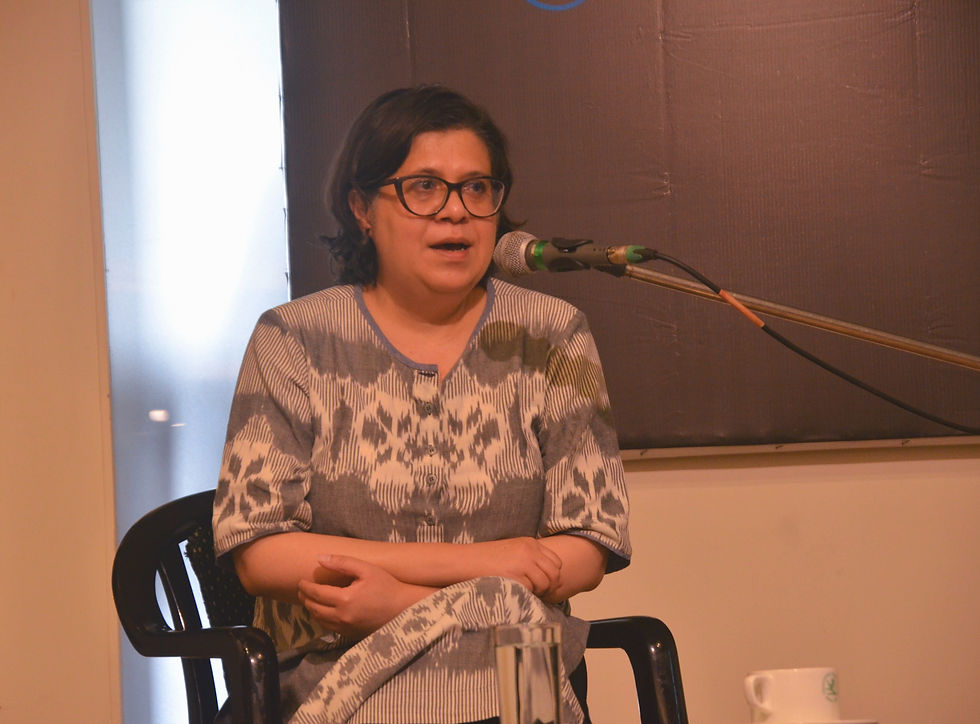
Alam opened by countering the prevalent liberal understanding of free speech as inclusive of hate speech, by arguing that all speech is not equal. Alam claimed that because law, corporate power and support of the media create social inequalities, speech cannot be understood divorced fromthe social context in which it is used. This framed Alam’s broader argument that distinguished offensive speech from hate speech. Alam believes that all episodic speech, that has the potential to offend and hurt the sentiments of a community or a group of people, can be considered offensive speech. But offensive speech can only amount to hate speech when it targets the minority, comes from a person belonging to the majority community, and paves the way for spreading material harm towards the former on the basis of their minority identity. Hate speech is therefore a form of marginalization and discrimination; because the minority holds unequal social and political power, they are unable to respond in a proportionate manner, which causes a ‘democratic process deficit’.
Alam also observed the possibility of setting a judicial precedent that positively discriminates against Muslims to protect them from majoritarian hate speech (similar to other Indian laws against caste and gender discrimination that makes special accommodations). Alam noted that murky power dynamics between intersecting identities within a community that diffuses clean boundaries between the majority and the minority renders this a tricky task for the court.
Finally, drawing from a slew of flimsy and bigoted FIRs filed by the Delhi police against Muslims for divisive speech during the December 2019 anti-government protests, that were heard by the SC, Alam argued that by admitting such cases the SC is normalizing the use of Islamophobic language in legal spaces and participating in the discourse of majoritarian violence. For instance, Alam noted, that Muslim students and political activists are often booked for violent speech under Section 15 of the Unlawful Activities (Prevention) Act which outlaws attacks upon the territory of India with ‘lethal weapons and/or noxious gases’. By admitting them, the SC sees fit to hear cases where the public prosecutor alleges that speech by Muslims constitute noxious gases and Muslim bodies constitute lethal weapons. Alam also noted that several judgments of the SC make references to religious tolerance in the Hindu scriptures. Recently an SC bench claimed Hinduism as the greatest religion in metaphysics. Alam warned of the consequence of such majoritarian language making its way into legal precedents, particularly in cases relating to hate speech.
The final speaker of the day, advocate and founder of the Criminal Justice and Police Accountability Project, Nikita Sonavane drew from her own litigation and quantitative research work to discuss the criminalization and policing of oppressed caste communities in central India. Through her talk, Casteist Carcerality: The Case of ‘Habitual Offenders’ in India, she discussed the criminalization of Denotified Tribes/Vimuktas and their legal classification as habitual offenders in Indian criminal law. Sonavane also highlighted how colonial-era law created mechanisms to reify the Brahmanical stratification of Hindu society along the lines of caste.
Sonavane opened by scrutinizing the Criminal Tribes Act of 1871 codified by the British colonial government. The law categorized 200 Indian tribes as ‘criminals by birth’, created settlements for the ‘criminal’ denotified tribes to sedentarize them, and maintained records of their private lives in criminal registers. The datafication central to the enforcement of this law later transitioned the denotified tribes into the legal category of ‘habitual offenders.’ All members of the Indian constituent assembly voted in favour of upholding the colonial-era law in the new Indian Constitution, arguing that members of the denotified tribes are ‘bad characters’ and are ‘born criminals, and must be surveilled for the protection of law and order. Thus, in line with this law, members of denotified tribes continue to be routinely subjected to excessive, unjustified policing. Sonvane related the case of a tribe in Madhya Pradesh that is legally obliged to submit an invite and a guest list to the local police station before hosting a wedding; the law’s innate assumption is that when this community gathers it is for a criminal purpose. Children born to denotified tribes can be taken away by the state to protect them from their ‘criminal’ parents.
Sonavane discussed the quantitative research undertaken by the CPA project which examined the FIRs and arrest records surrounding violations of excise law in Madhya Pradesh. An overwhelming majority of those incriminated were found to be members of denotified tribes. When cases were taken to court, hearing benches would often dismiss bail pleas on the grounds that the perpetrator was a habitual offender because they belonged to a denotified tribe. Sonavane noted that in order to be considered a habitual offender by the law, members of denotified tribes do not need to be convicted by the law. For instance, because the MP police have registered a series of spurious FIRs against tribal women who work in the production of a local form of alcohol—Mahua—the court is able to dismiss their bail pleas on the grounds that they are habitual offenders. However, the court has never found them guilty of the offences they have been alleged to have committed. Sonavane claimed that Mahua-brewing tribal women pose a challenge to the cultural norms and upper-caste values that the ‘good’ Hindu woman is expected to embody.
Sonavane concluded with a reflection on Brahminical patriarchy and the Hindu caste system as a set of norms that constitutes Indian law. She underscored the embeddedness of caste in law, as opposed to liberal understandings of caste being reinforced by the law. Sonavane invited teachers to lay this fact bare in social science classrooms and urged audience members to read the text of Hindu scriptures that delineate caste, if they wanted to reckon with its lasting social effects.
DAY 3 | August 5, 2023
The final day of the conference opened with Rustom Bharucha's powerful presentation on The Search of Justice through Failures of Reconciliation, The Volatility of Dissent and Systemic Forgetting: A Performative Analysis. Despite firmly believing in retributive justice, he recognizes the disjunct ordinary citizens may experience from institutional law in their search for justice. Hence, citizens must search for justice outside the legal system, enacting and activating it in their own forums. Using case studies such as the Truth and Reconciliation Commission (TRC) in South Africa, the reinvented Gacacas in Rwanda, prison theatre in Durban and photographs of the Covid pandemic in India, Bharucha’s talk probed the breakthroughs, dead ends, contradictions and vulnerabilities of this external quest for justice.

The Truth and Reconciliation Commissions, believed to be essential in helping the nascent South African nation heal from the brutal experience of the Apartheid, gave voice to victims and their families. However, their heart-rending testimonies, despite supplementing forensic truth, often failed to address the everyday violence of the Apartheid or fulfil the survivors’ search for justice, as in the case of Nomonde Calata. The first part of the talk ended with a discussion of the reinvented gacacas in Rwanda, which in being allowed to try only Hutu and not Tutsi crimes, continued with the practice of ethnic discrimination that the nation was supposed to move beyond.
In the second part, Bharucha dwelt on his experiences in prison theatre at the Westville Correctional Centre in Durban, South Africa. He spoke of the first scene of a devised theatre piece that he worked on with the inmates where rape was depicted not as a palliative, but as a provocation. The inmates watched the scene in rapt silence, demonstrating the impact of this alternative mode of reaching out to justice.
The final part of Bharucha’s talk focussed on images taken during the Covid 19 pandemic in India, especially the migrant labour crisis and the devastating second wave. These photographs enable seeing as to becoming a political act. They constitute evidence, not merely data, of the governmental indifference to the right to life, to the criminal unavailability of oxygen and a counter to systematic forgetting. However, these very images, in being owned by external agencies, can also facilitate a consumerism of suffering.
Bharucha thus sees these experiments or quests for justice as positive failures. Despite the adversities faced by them, or their inability to fulfil their ultimate purpose, they are important steps in acknowledging the need for people to mobilize in order to seek justice on their own, should the law fail its mandate.
The conference ended with the much awaited conversation between Romila Thapar, Ranjit Hoskote and Naveen Kishore. The discussion was named The Question of Ethics.
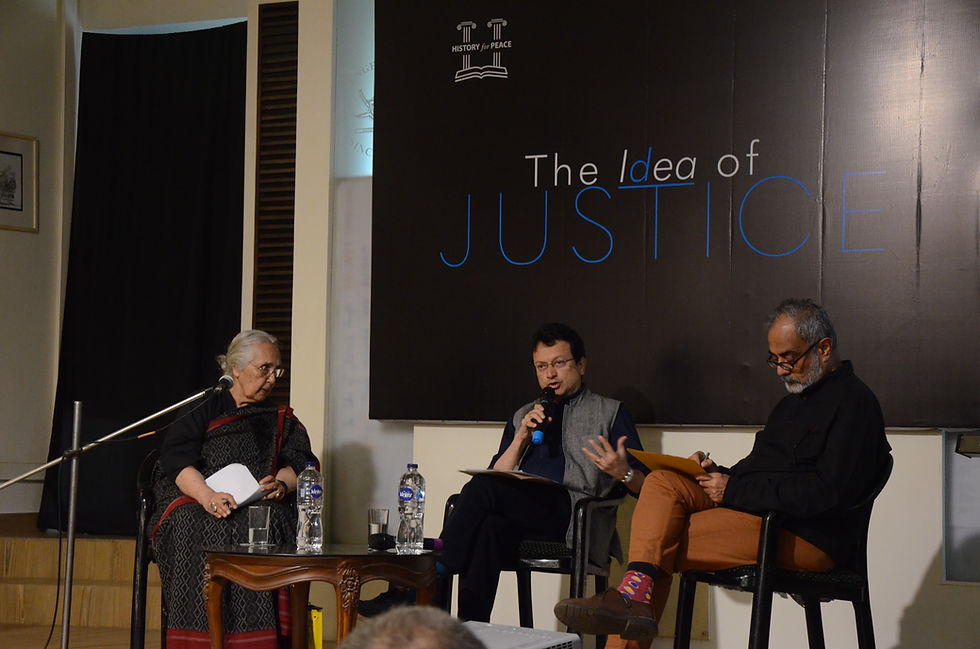
Romila Thapar opened the conversation urging the audience to find elements of yesterday in today. The past enables us to interrogate the intention of historical change and forces us to confront injustice embedded in much of our mythology. In mythology across the world one may find elements of ethnic cleansing and genocide. Can ethnic cleansing such as this happen without justice and does the supposed ‘justice’ of genocide override its injustice on the community being ‘cleansed’? Thapar turns to the historical example of Ashoka Maurya, who in the aftermath of the killings at Kalinga, is full of compassion for those that have died. Yet, why must this compassion be retrospective?
Thapar looks at philosophy and religion to see how the matter of justice and ethics enters the conversation. Referring to two seemingly juxtaposed religious traditions: the brahmanical tradition and the shramanic tradition, Thapar argues that the mind has to be trained to recognize justices as well as injustices. However, the law determines what these justices and injustices are. Who makes these laws and can unethical laws ever be in conformity with a ‘sense’ of justice? This impermanence of ethical laws makes mythology often turn to the divine when dealing with the question of ethics. Thapar recounts Shakuntala’s narrative, as told in Vyasa’s Mahabharata as well as Kalidasa’s Abhijnanasankuntalam. In both cases a potentially ethical situation presents itself where a grave injustice is done to Shakuntala when Dushyanta fails to recognize her. However, the solution provided in both cases is by celestial intervention. Why is ethics placed in the hands of the supernatural when it is often dealt by humans in the world?
Thapar argues that the power of the state lies in prescribing ethics in the form of laws. However, she reiterates the impermanence of these laws with the mutation of societies and shows that even the notion of ethics is subject to change. However, if we were to understand social ethics i.e the understanding of many ethics that may change and transform as societies do, she asks, perhaps rhetorically, ‘Is politics bereft of ethics now?’
Ranjit Hoskote broadened the scope of ethics, questioning whether it applies only to the human species. He raised two themes: territoriality and access to space and resources. Giving the example of forest land, he explains that a territory was captured by the colonizers and its resources were put to use in their service. Animals and indigenous tribes were disenfranchised, without recourse to any remedy. Advocates may speak on their behalf but they are unable to voice the great injustice being done to them. Founded on radical violation, Hoskote declares that we are in a ‘state of emergency with the environment.’
The founding of such a state of emergency, Hoskote finds, is in human beings’ understanding of themselves as a sovereign species. The Enlightenment in Europe replaced God, placing all other species in service of mankind. Underlying this was a propertarian understanding that the planet existed for man. Remembering Akeel Bilgrami’s words, Hoskote quotes him: ‘How and when did we transform the concept of nature into the concept of natural resources?’ Ending on a note of hope, Hoskote says that a leap of faith is required to create an ethic conditioned by the practice of equity through listening, translation and the search for a common ground.
Naveen Kishore uses his passion for photography to reflect on the need to ruminate and reason rather than follow the unreasonable. Kishore recounts his urge to photograph in the aftermath of the 2002 riots. His camera allowed him to capture the horrors he bore witness to. Thus, his photography, was different from ‘evidence’. It allowed him to engage with the source, capture the atrocity and the effect of it in one click. The photograph allowed him to create a form of text while ordinary people were being thrust into the grapples of history as it unfolds.
The unethical, Kishore said, drawing from Hannah Arendt’s words, made evil seem banal. However, banal was no longer an apt term to describe our present predicament, and evil is a deliberate malice. To battle it, one has to look beyond reason and reflect on the intuitive. Innocence is not an option while inaction only reveals a perpetual fear to ‘act-live’. History is being thrust onto us, Kishore states, creating the fear of imagined ‘others’. He beseeches the audience to reflect on our responsibility towards the ‘other’. He reminds us that the burden to be the bridge between ourselves and the other, is ours. Perhaps a reminder of this responsibility would create a moment of pause as we burn the bridges we wish to protect.
WORKSHOPS
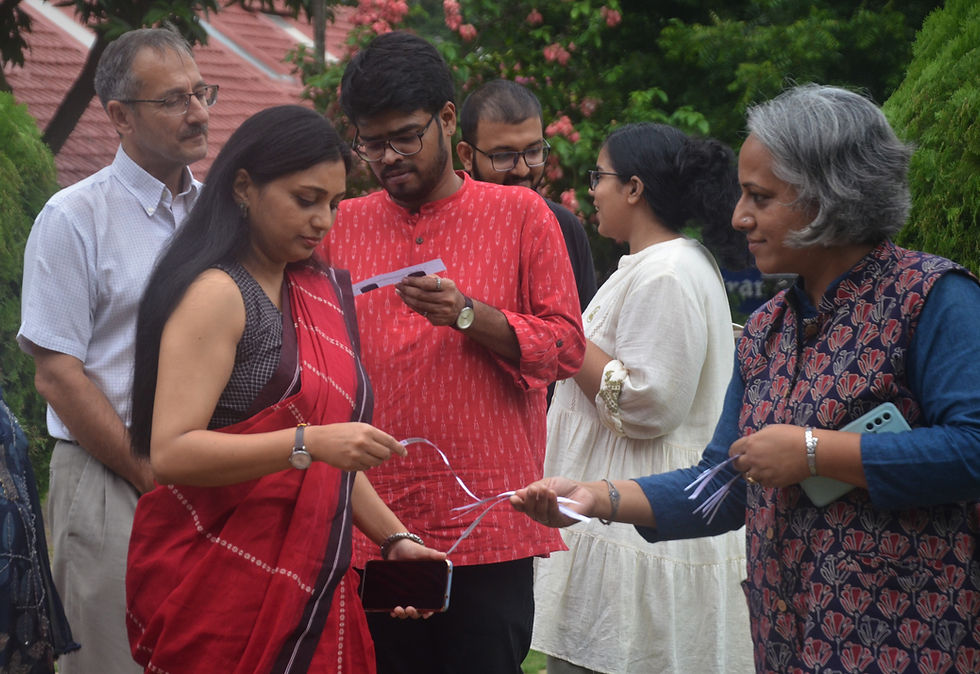
Questions of Justice—Through the Writings of Mahasweta Devi
Anjum Katyal
Anjum Katyal, who on many instances has translated works of Mahasweta Devi for Seagull Books, drew from Mahasweta Devi’s text Truth/Untruth in her workshop to address questions of social injustice through literature and films in the classroom. The participants were divided into groups according to the classes they teach. She opened with inviting responses from teachers for the kinds of injustices they see most commonly in the society around them. The responses varied from gender, religion, class, access to resources, caste as markers of identity etc. There onwards, she read out an excerpt from Mahasweta Devi’s short story Kunti and the Nishadin. The participants were invited to listen closely and analyse the kinds of injustices that were being meted out in the story and how that translates in the lives of the protagonists. The responses to this varied from caste, class, the differential treatment towards widows, rural urban divide, among other things. Drawing from this, they were given half an hour to find a particular instance from literature, film or advertisements to demonstrate how they would use that piece to introduce a classroom discussion around forms of social injustice and present it as a lesson plan or workshop before the larger group. This brought in a range of responses across the three days from Harry Potter, the Ramayana, To Kill a Mockingbird, The Pied Piper of Hamelin, Valmiki Pratibha, Oppenheimer, Article 15, The Pantene advertisement, Barbie among others. This threw open avenues for significant discussion around what we understand as injustice, the forms that it might assume, the subtle ways in which it transforms itself, the subjectiveness of conversations like this in the classroom. There were further substantial interventions when one of the participants pointed out that while we certainly could use Harry Potter in building this conversation around injustice in a classroom, we must also bear in mind the problematic views on transgender rights issued by that same author since. This will then open avenues for teachers to bring in these sensitive dilemmas in otherwise linear narratives. While recognizing the relevance and the immense popular appeal of the books among school students, it is important that we draw on it for societal conversations. In doing so, the students must be encouraged to simultaneously read the author and be conscious of her standpoint while engaging with the text. Similarly, another participant pointed out that while the Pantene advertisement is a significant step in popular media towards sensitising against gender stereotyping and the labels that it comes with, we cannot and must not lose sight of the fact that it was created by a big corporate house with vested interests. This further pushed them to think in the context of history lessons where students should be encouraged to read the historian as much as the source, to arrive at a more holistic reading of any moment in history.
The Idea of Justice through Power, Privilege and Allyship
Ranjani Ramanathan & Charlene Judith Pereira [Schools of Equality]
The workshop, led wonderfully through meaningful conversations and fun activities, aimed to break down the basic concept of intersectionality and relate it to power, privilege and justice within the school community and the classroom.The workshop began with an exploration of power dynamics and how they contribute to social inequality. Participants discussed the various forms of power, including systemic, institutional and individual power, and how they intersect with factors like race, gender, class and more. The facilitators emphasised the importance of recognizing these power structures to achieve justice.
Participants engaged in discussions on how to navigate and address these intersections when advocating for justice, ensuring that no aspect of a person's identity is overlooked. The participants were engaged and encouraged to interact through the Power Flower activity which involved acknowledging privileges and getting a sense of the power structure in the room. The activities helped the participants to understand the ideas of marginalisation among social groups, leading to heightened sensitivity in dealing with children and peers. The teachers were urged to include diverse perspectives in the curriculum and address micro aggression in the classrooms. The stance of staying neutral about a sensitive issue in front of the students was also analysed and debated upon. A key aspect that the workshop addressed is how allyship works in educational spaces, and how to make others feel heard, while being sensitive towards their differences.
Through group activities and discussions, participants examined their own privileges and learned to recognize the ways in which privilege can shape perceptions, opportunities and life experiences. The workshop emphasized that acknowledging and understanding one's own privilege is a crucial step towards effective allyship. Real-world case studies and examples were presented to illustrate the concepts being discussed. Participants analysed current social justice movements, their successes and challenges, and brainstormed practical ways to implement the ideas of justice, power, privilege and allyship in their personal and professional lives. The workshop underscored the importance of ongoing education, self-reflection and collective action in the pursuit of social justice.
Nurturing A Mindset of Justice—The Whole School Approach
Neha Pradhan Arora
This workshop depicted how a whole school approach with multiple elements integrated into the curriculum and the school calendar is the most impactful and effective way to nurture a mindset that helps us question injustice and equips us with the skills to work towards justice in the education space. The workshop started with a fun outdoor activity with participants working in pairs and identifying power and privileges given to their roles in the game. It analysed important questions about private and public life, life choices, education and work spheres and intersectionality.
The participants were urged to research their identities during the games and discuss assumptions and facts regarding those with their fellow educators. This process was used to understand how one can nurture a mindset of justice.
The workshops progressed to explore how this mindset can be nurtured in students using a whole school approached based on an adaptation of the Six Elements of Social Justice Curriculum Design framework. These elements are –
Self love and knowledge
Respect for others
Exploring issues of injustice
Social movements and change
Raising awareness
Taking action
The “whole school approach,” emphasizes that justice and equity should permeate every facet of a school's operations. Participants explored how curriculum development, teaching methodologies in class or outside, life skills and other programmes, community outreach and engagement, theme-based events in the school calendar and policies for inclusion, safeguarding and sustainability can all contribute towards nurturing a culture of justice and the skills for advocacy. They also reflected on current practices in their own schools which may already be doing this.
Primarily the workshop, through examples of classroom and school practices, urged the participants to develop within themselves an ability to see the world through the lens of justice even as they defined ways to work towards a just, equitable and sustainable world.
Compiled by Anchita Dasgupta, Mayukhi Ghosh, Pratyusha Chakrabarti, Srilagna Majumdar and Rajosmita Roy. Photographs by Pratyusha Chakrabarti and Sripurna Majumdar.








Comments